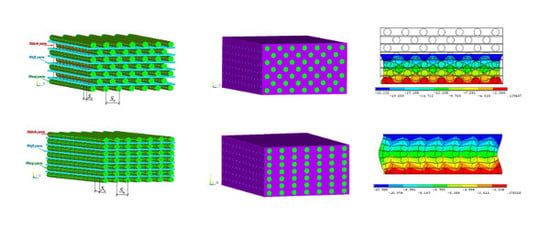Finite Element Analysis of Three-Dimensional (3D) Auxetic Textile Composite under Compression
Abstract
:1. Introduction
2. Methodology
2.1. Brief Introduction of 3D Auxetic Textile Composite
2.2. Finite Element Modeling
2.3. Calculation of Compression Behavior
3. Results and Discussion
3.1. Verification of FE Simulation
3.2. Typical Compression Behavior of Auxetic Composite
3.3. Effect of Geometrical Parameters of 3D Textile Composites
3.4. Effect of Yarns Properties
3.5. Effects of PU Foam Properties
4. Conclusions
- Auxetic and non-auxetic composites have different compression behaviors due to different yarn arrangements in their 3D textile reinforcement structure. While the auxetic composite behaves as a softer material, the non-auxetic composite behaves as a stiffer material. The auxetic composite has much better EAC than the non-auxetic composite made with the same structural parameters and constituent material properties.
- All of the structural parameters and constituent material properties have different effects on the compression properties of auxtic and non-auxetic composites. For geometry effects, the decrease of ξ1 and increase of ξ2 can result in the increase of the compression stress and decrease of the EAC of the auxetic composite. For yarn property effects, the increase of E* can cause the increase of the compression stress and the decrease of the EAC of auxetic composite, but E′ has no effect on these properties. For PU foam effects, the increase of its initial shear modulus can result in the increase of the compression stress and the decrease of both EAC and auxetic behavior of auxetic composite.
- The effects of PR depend on the level of compression strain and stress. At low compression strain and stress, changing PR of PU foam from positive to negative can cause the increase of the compression stress, but the decrease of both EAC and auxetic effect of auxetic composite. At high compression strain and stress, the effects of PR of PU foam are just opposite. Thus, the compression properties of auxetic composites can be tailored by proper selecting structural parameters and constituent material properties.
Acknowledgments
Author Contributions
Conflicts of Interest
Appendix A. Size Effect of Finite Element Model

Appendix B. Mechanical Behaviors of PU Foam
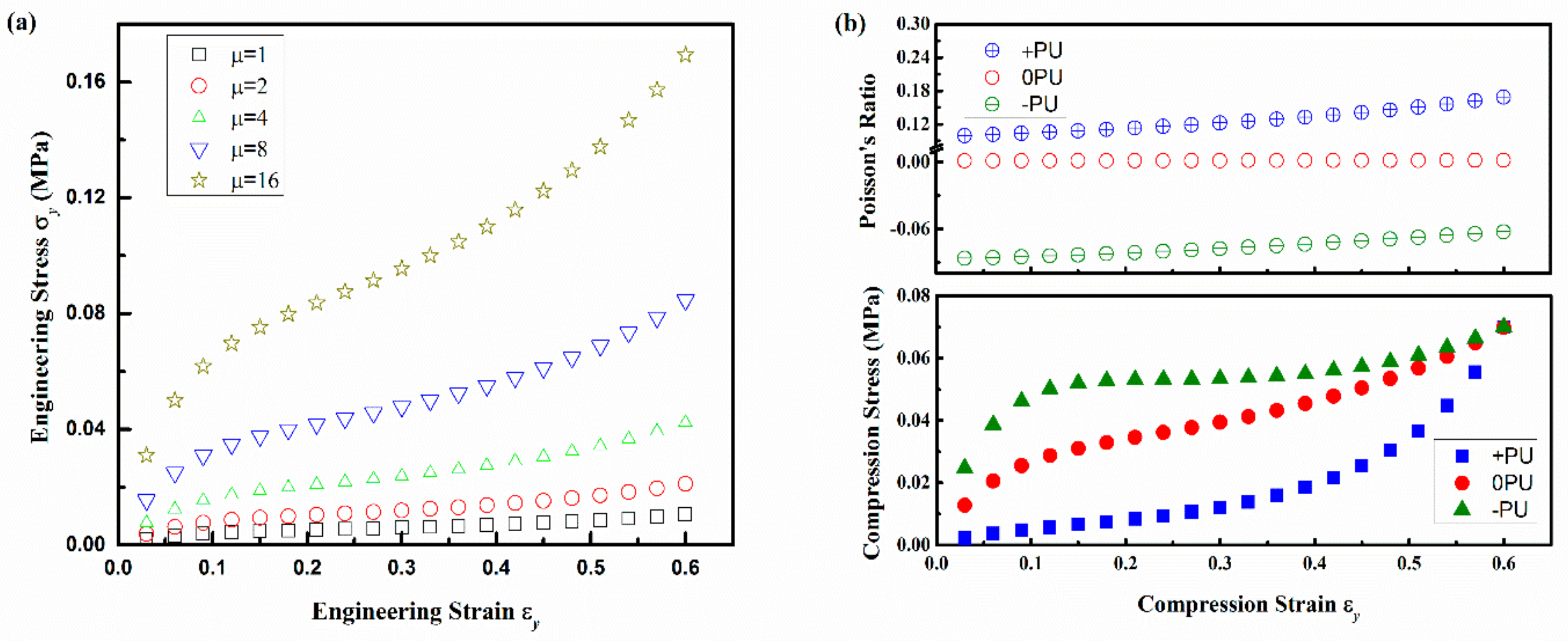
| Group | Definition | μ1 (kPa) | μ2 (kPa) | α1 | α2 | β1 | β2 |
|---|---|---|---|---|---|---|---|
| Group 1 | μ = 1 | 2.4 | 1.8 | 19.8 | 19.7 | 1.4 × 10−3 | 6.6 × 10−4 |
| μ = 2 | 4.8 | 3.5 | 19.8 | 19.7 | 1.4 × 10−3 | 6.6 × 10−4 | |
| μ = 4 | 9.6 | 7.0 | 19.8 | 19.7 | 1.4 × 10−3 | 6.6 × 10−4 | |
| μ = 8 | 19.2 | 14.0 | 19.8 | 19.7 | 1.4 × 10−3 | 6.6 × 10−4 | |
| μ = 16 | 38.4 | 28.0 | 19.8 | 19.7 | 1.4 × 10−3 | 6.6 × 10−4 | |
| Group 2 | +PU | 2.4 | 1.8 | 19.8 | 19.7 | 1.4 × 10−1 | 6.6 × 10−2 |
| 0PU | 15.8 | 11.6 | 19.8 | 19.7 | 1.4 × 10−3 | 6.6 × 10−4 | |
| −PU | 34.5 | 25.2 | 19.8 | 19.7 | −1.4 × 10−1 | 6.6 × 10−4 |
References
- Ramirez, M.; Nava-Gomez, G.G.; Sabina, F.J.; Camacho-Montes, H.; Guinovart-Diaz, R.; Rodriguez-Ramos, R.; Bravo-Castillero, J. Enhancement of Young’s moduli and auxetic windows in laminates with isotropic constituents. Int. J. Eng. Sci. 2012, 58, 95–114. [Google Scholar] [CrossRef]
- Zhou, L.; Jiang, L.L.; Hu, H. Auxetic composites made of 3D textile structure and polyurethane foam. Phys. Status Solidi B Basic Solid State Phys. 2016, 253, 1331–1341. [Google Scholar] [CrossRef]
- Sanami, M.; Ravirala, N.; Alderson, K.; Alderson, A. Auxetic materials for sports applications. In Engineering of Sport 10; James, D., Choppin, S., Allen, T., Wheat, J., Fleming, P., Eds.; Elsevier Science Bv: Amsterdam, The Netherlands, 2014; pp. 453–458. [Google Scholar]
- Alderson, K.L.; Simkins, V.R.; Coenen, V.L.; Davies, P.J.; Alderson, A.; Evans, K.E. How to make auxetic fibre reinforced composites. Phys. Status Solidi B Basic Solid State Phys. 2005, 242, 509–518. [Google Scholar] [CrossRef]
- Wei, G.Y.; Edwards, S.F. Auxeticity windows for composites. Phys. A Stat. Mech. Appl. 1998, 258, 5–10. [Google Scholar] [CrossRef]
- Wang, Y.C.; Lakes, R.S. Composites with inclusions of negative bulk modulus: Extreme damping and negative Poisson’s ratio. J. Compos. Mater. 2005, 39, 1645–1657. [Google Scholar] [CrossRef]
- Evans, K.E.; Donoghue, J.P.; Alderson, K.L. The design, matching and manufacture of auxetic carbon fibre laminates. J. Compos. Mater. 2004, 38, 95–106. [Google Scholar] [CrossRef]
- Zhang, R.G.; Yeh, H.L.; Yeh, H.Y. A discussion of negative Poisson’s ratio design for composites. J. Reinf. Plast. Compos. 1999, 18, 1546–1556. [Google Scholar] [CrossRef]
- Yeh, H.L.; Yeh, H.Y.; Zhang, R.G. A study of negative Poisson’s ratio in randomly oriented quasi-isotropic composite laminates. J. Compos. Mater. 1999, 33, 1843–1857. [Google Scholar] [CrossRef]
- Harkati, E.H.; Bezazi, A.; Scarpa, F.; Alderson, K.; Alderson, A. Modelling the influence of the orientation and fibre reinforcement on the Negative Poisson’s ratio in composite laminates. Phys. Status Solidi B Basic Solid State Phys. 2007, 244, 883–892. [Google Scholar] [CrossRef]
- Milton, G.W. Composite materials with poisson’s ratios close to—1. J. Mech. Phys. Solids 1992, 40, 1105–1137. [Google Scholar] [CrossRef]
- Alderson, K.L.; Coenen, V.L. The low velocity impact response of auxetic carbon fibre laminates. Phys. Status Solidi B Basic Solid State Phys. 2008, 245, 489–496. [Google Scholar] [CrossRef]
- Hu, H.; Silberschmidt, V. A composite material with Poisson’s ratio tunable from positive to negative values: an experimental and numerical study. J. Mater. Sci. 2013, 48, 8493–8500. [Google Scholar] [CrossRef]
- Hou, X.N.; Hu, H.; Silberschmidt, V. Numerical analysis of composite structure with in-plane isotropic negative Poisson’s ratio: Effects of materials properties and geometry features of inclusions. Compos. Part B Eng. 2014, 58, 152–159. [Google Scholar] [CrossRef]
- Hou, X.N.; Hu, H.; Silberschmidt, V. A novel concept to develop composite structures with isotropic negative Poisson’s ratio: Effects of random inclusions. Compos. Sci. Technol. 2012, 72, 1848–1854. [Google Scholar] [CrossRef]
- Hou, X.N.; Hu, H. A novel 3D composite structure with tunable Poisson’s ratio and stiffness. Phys. Status Solidi B Basic Solid State Phys. 2015, 252, 1565–1574. [Google Scholar] [CrossRef]
- Hou, X.N.; Hu, H.; Silberschmidt, V. Tailoring structure of inclusion with strain-induced closure to reduce Poisson’s ratio of composite materials. J. Appl. Phys. 2014, 115, 224903. [Google Scholar] [CrossRef]
- Li, D.; Dong, L.; Yin, J.H.; Lakes, R.S. Negative Poisson’s ratio in 2D Voronoi cellular solids by biaxial compression: A numerical study. J. Mater. Sci. 2016, 51, 7029–7037. [Google Scholar] [CrossRef]
- Zhou, J.L.; Deng, X.B.; Yan, Y.; Chen, X.; Liu, Y.L. Superelasticity and reversible energy absorption of polyurethane cellular structures with sand filler. Compos. Struct. 2015, 131, 966–974. [Google Scholar] [CrossRef]
- Qiao, J.X.; Chen, C.Q. Analyses on the In-Plane Impact Resistance of Auxetic Double Arrowhead Honeycombs. J. Appl. Mech. Trans. ASME 2015, 82, 051007. [Google Scholar] [CrossRef]
- Qiao, J.X.; Chen, C.Q. Impact resistance of uniform and functionally graded auxetic double arrowhead honeycombs. Int. J. Impact Eng. 2015, 83, 47–58. [Google Scholar] [CrossRef]
- Saxena, K.K.; Das, R.; Calius, E.P. Three Decades of Auxetics Research—Materials with Negative Poisson’s Ratio: A Review. Adv. Eng. Mater. 2016, 18, 1847–1870. [Google Scholar] [CrossRef]
- Bruggi, M.; Zega, V.; Corigliano, A. Synthesis of auxetic structures using optimization of compliant mechanisms and a micropolar material model. Struct. Multidiscip. Optim. 2017, 55, 1–12. [Google Scholar] [CrossRef] [Green Version]
- Ge, Z.Y.; Hu, H. A theoretical analysis of deformation behavior of an innovative 3D auxetic textile structure. J. Text. Inst. 2015, 106, 101–109. [Google Scholar] [CrossRef]
- Ge, Z.Y.; Hu, H. Innovative three-dimensional fabric structure with negative Poisson’s ratio for composite reinforcement. Text. Res. J. 2013, 83, 543–550. [Google Scholar] [CrossRef]
- Ge, Z.Y.; Hu, H.; Liu, Y.P. Numerical analysis of deformation behavior of a 3D textile structure with negative Poisson’s ratio under compression. Text. Res. J. 2015, 85, 548–557. [Google Scholar] [CrossRef]
- Ge, Z.Y.; Hu, H.; Liu, Y.P. A finite element analysis of a 3D auxetic textile structure for composite reinforcement. Smart Mater. Struct. 2013, 22, 084005. [Google Scholar] [CrossRef]
- Zeng, J.F.; Hu, H.; Zhou, L. A study on negative Poisson’s ratio effect of 3D auxetic orthogonal textile composites under compression. Smart Mater. Struct. 2017, 26, 365014. [Google Scholar] [CrossRef]
- Zhou, L.; Zeng, J.F.; Jiang, L.L.; Hu, H. Low velocity impact properties of 3D auxetic textile composite. J. Mater. Sci. 2018, 53, 3899–3914. [Google Scholar] [CrossRef]
- Jiang, L.L.; Gu, B.H.; Hu, H. Auxetic composite made with multilayer orthogonal structural reinforcement. Compos. Struct. 2016, 135, 23–29. [Google Scholar] [CrossRef]
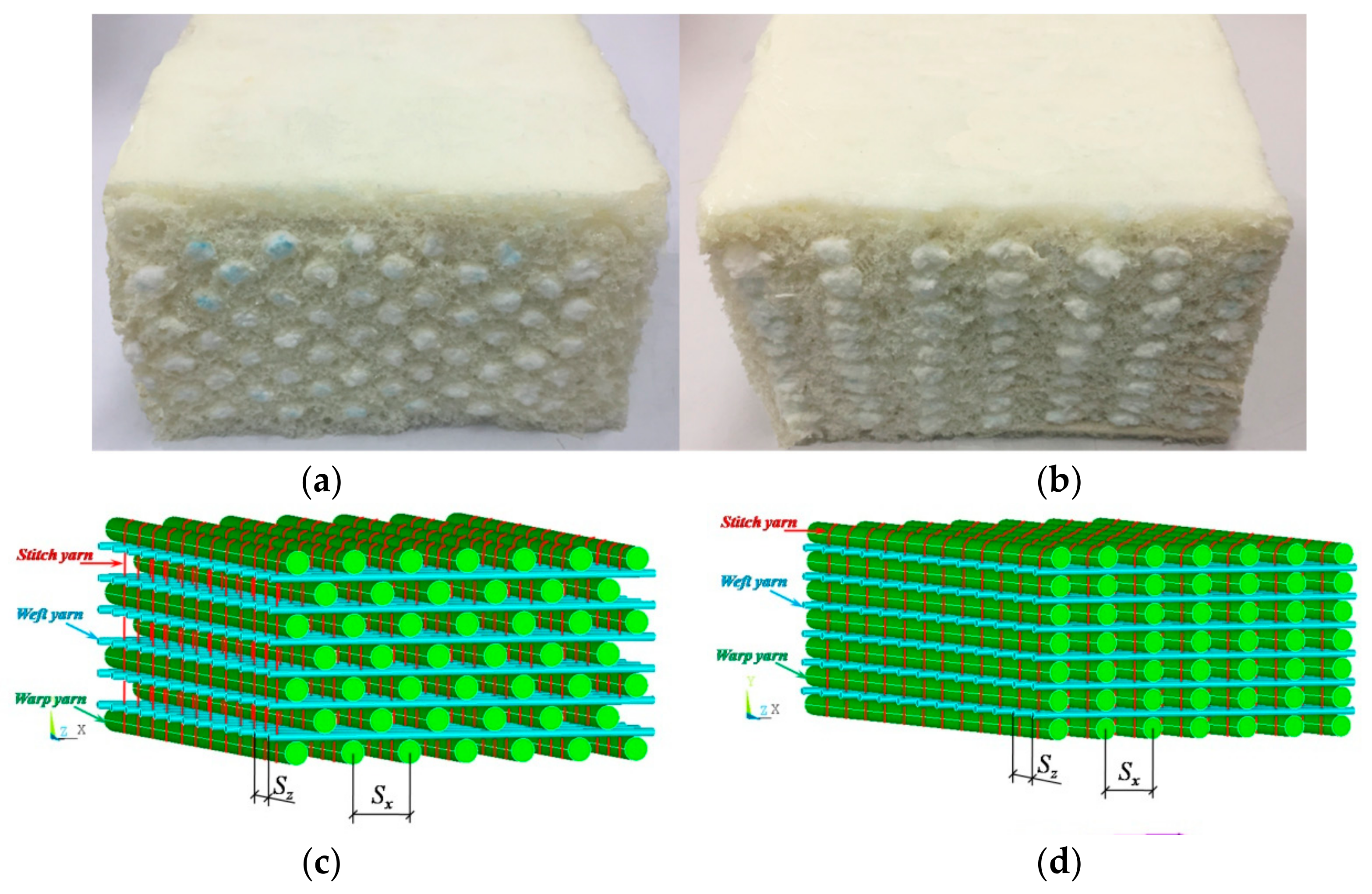

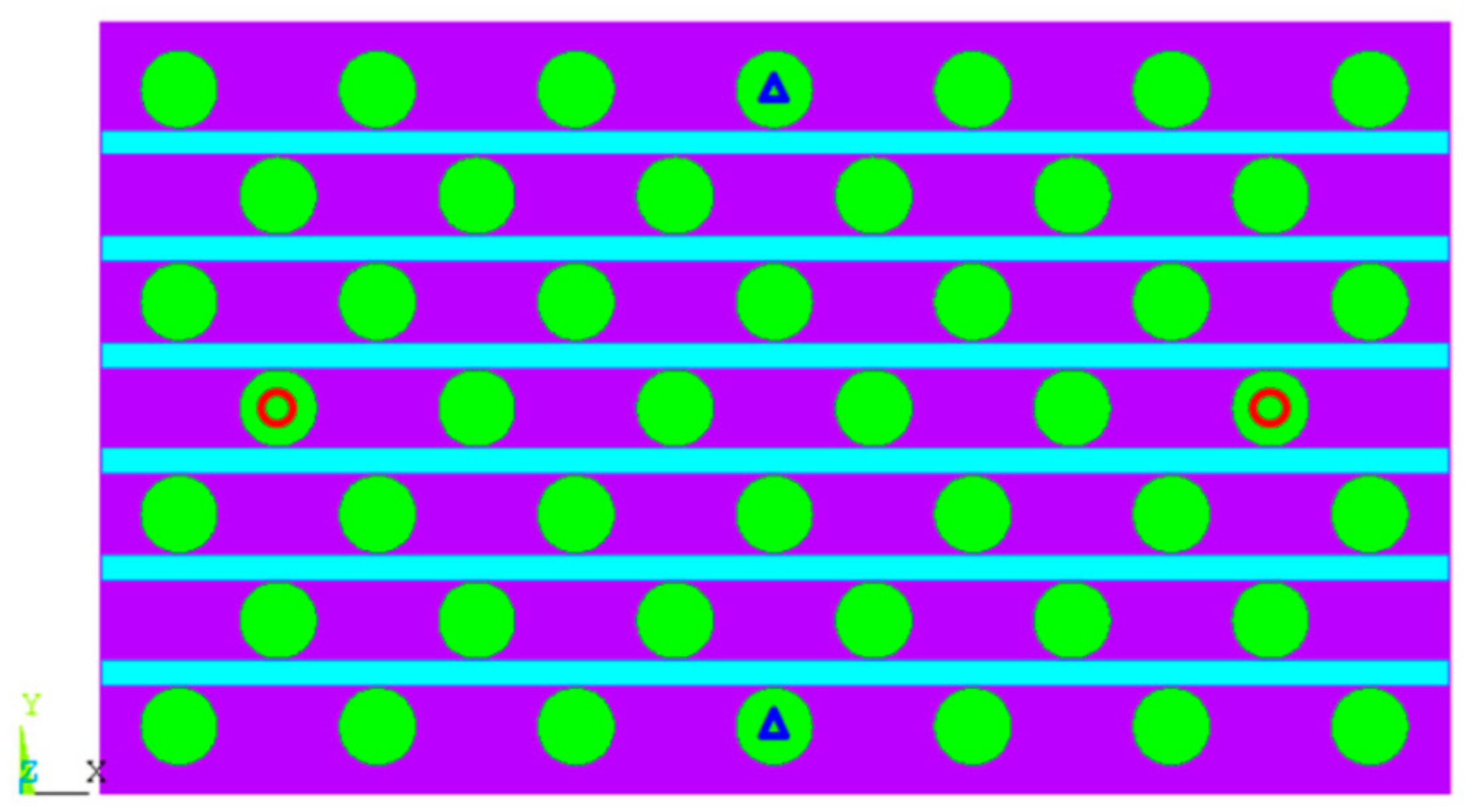
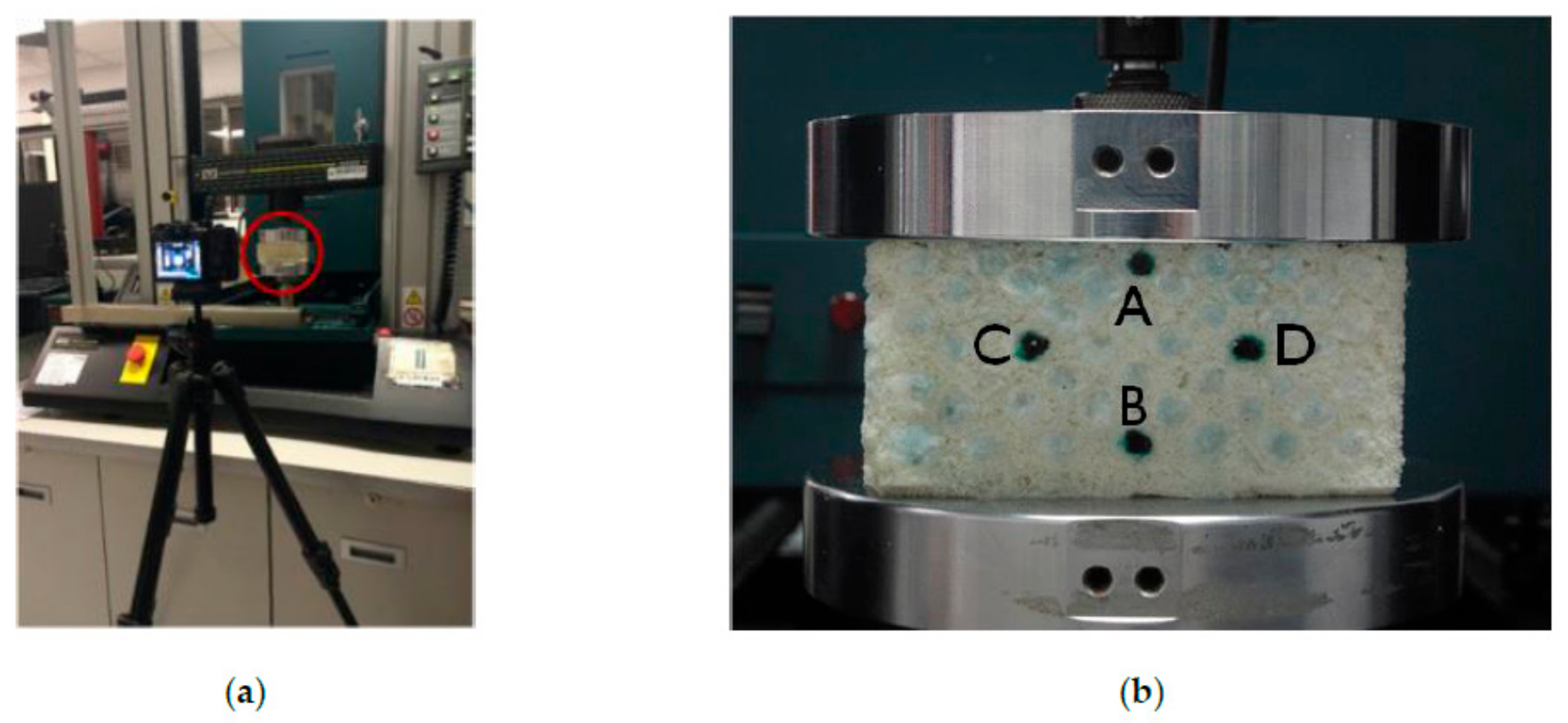
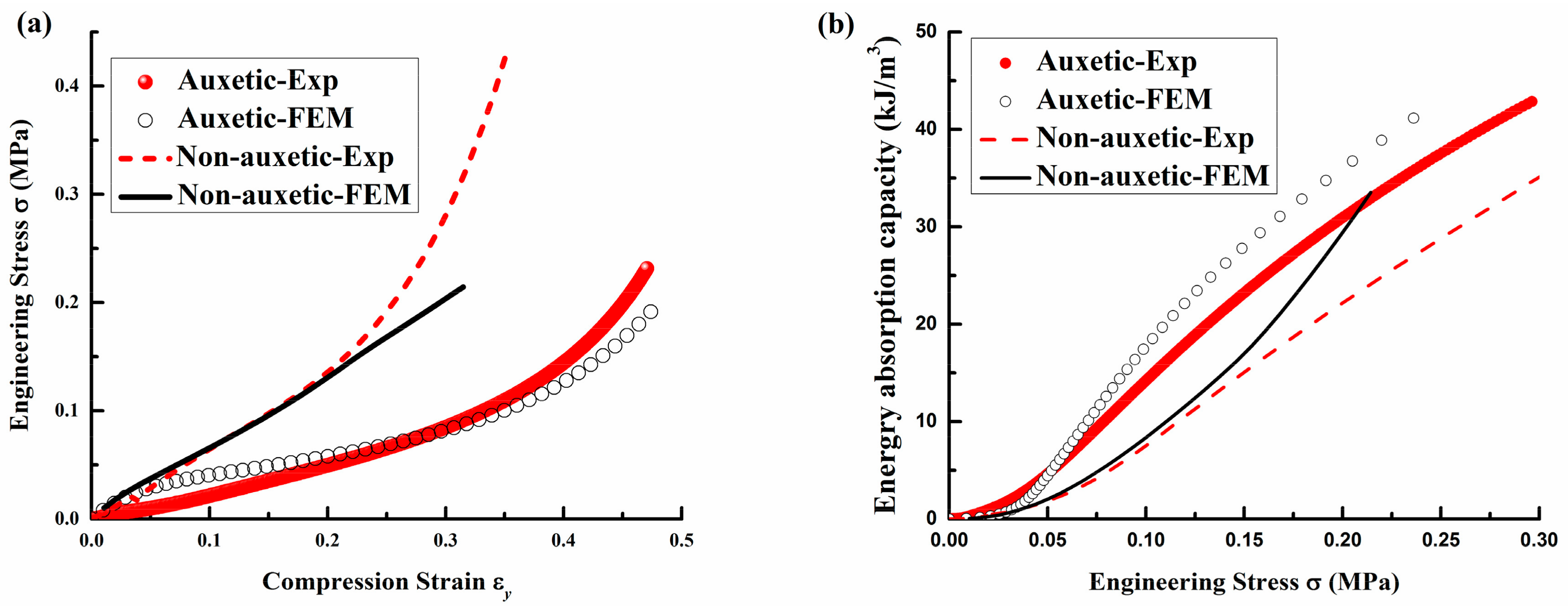
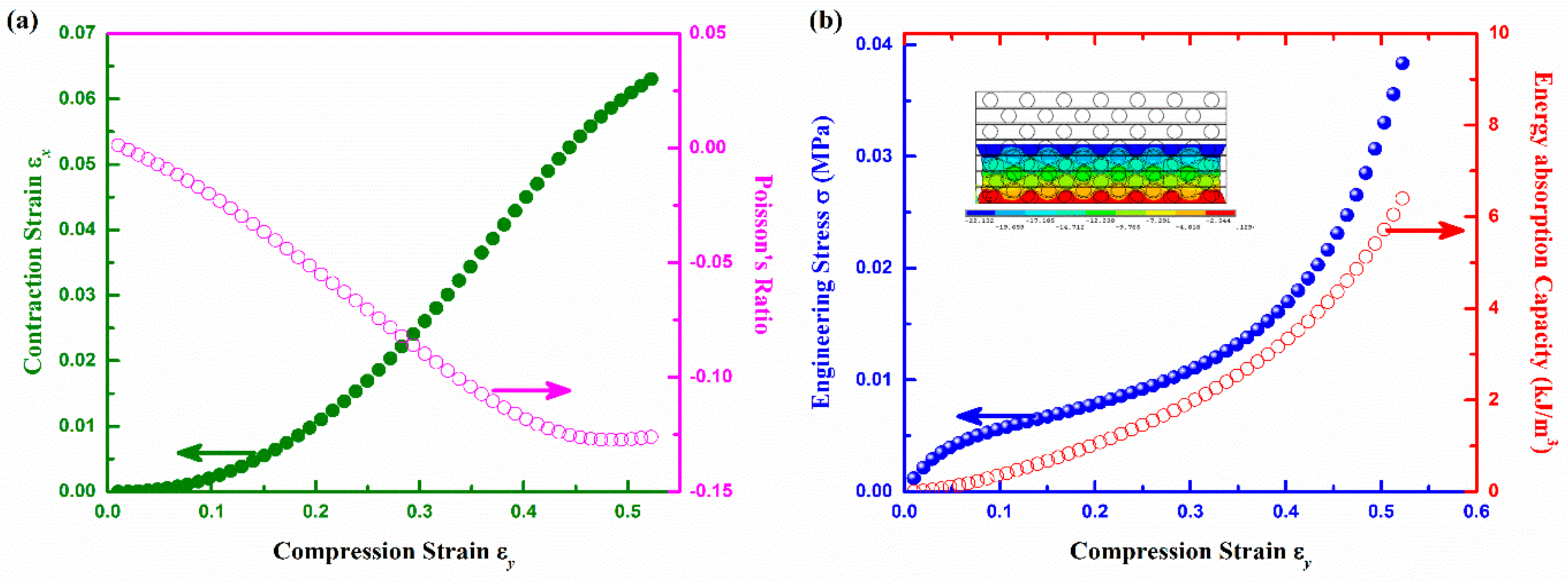

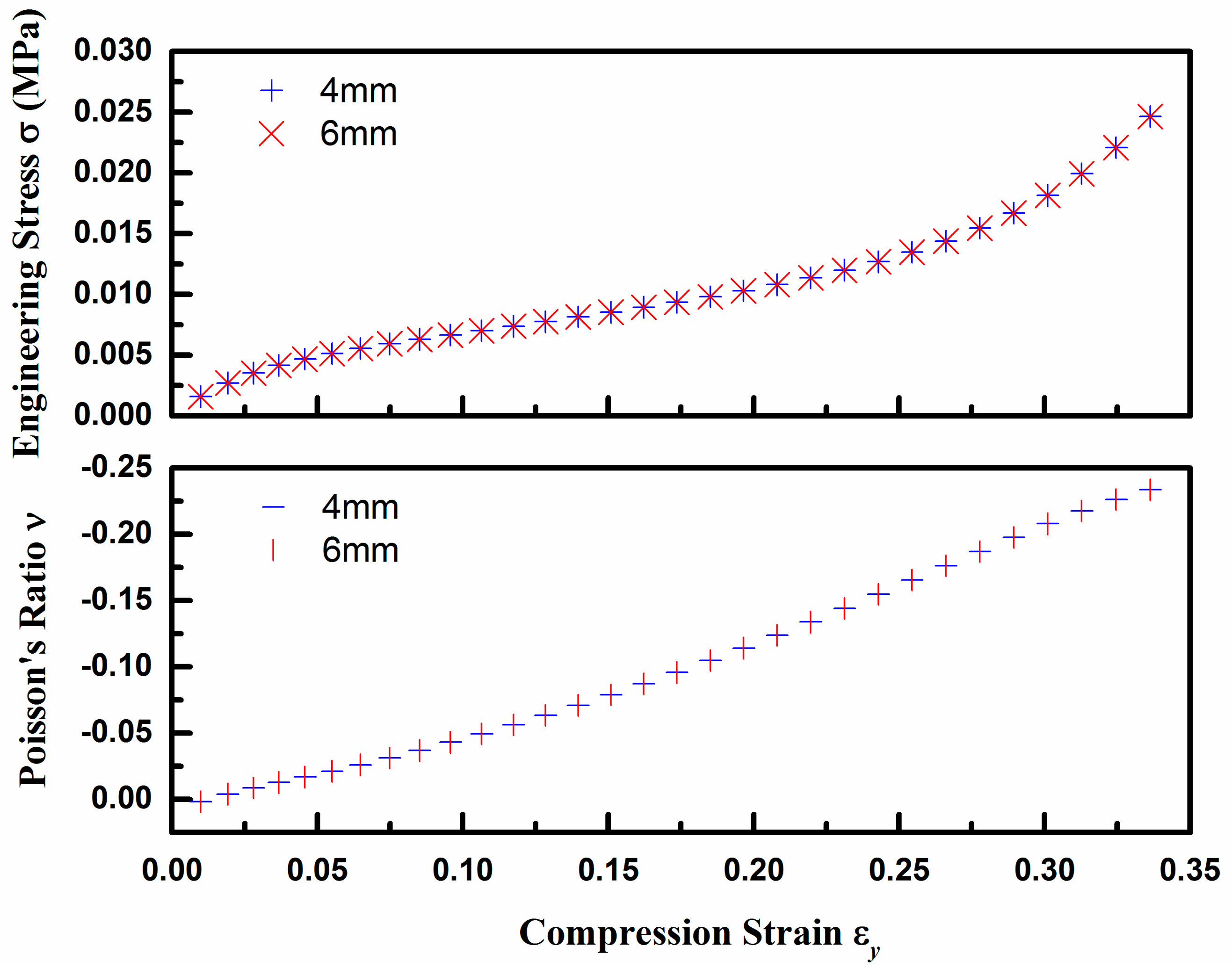
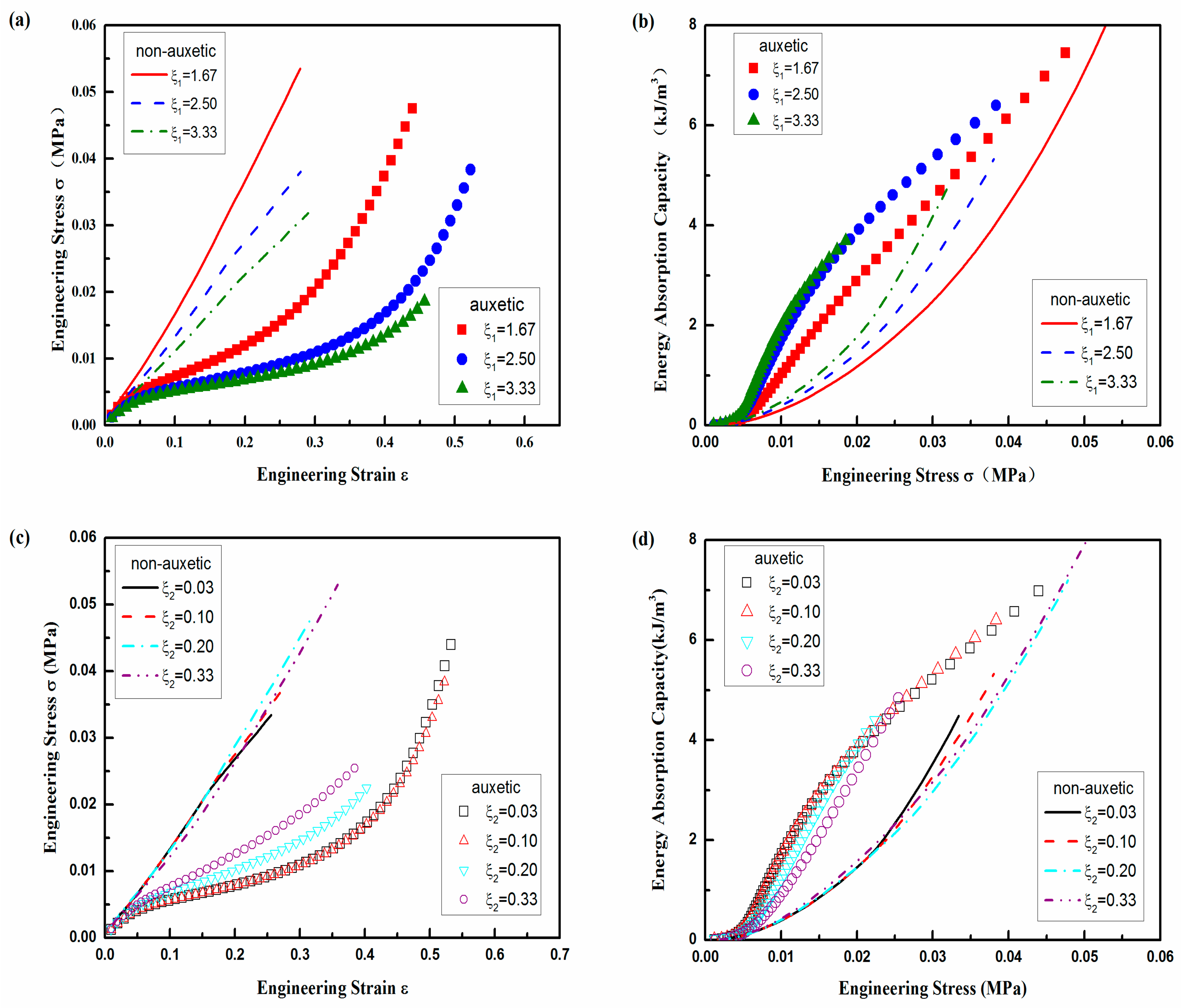
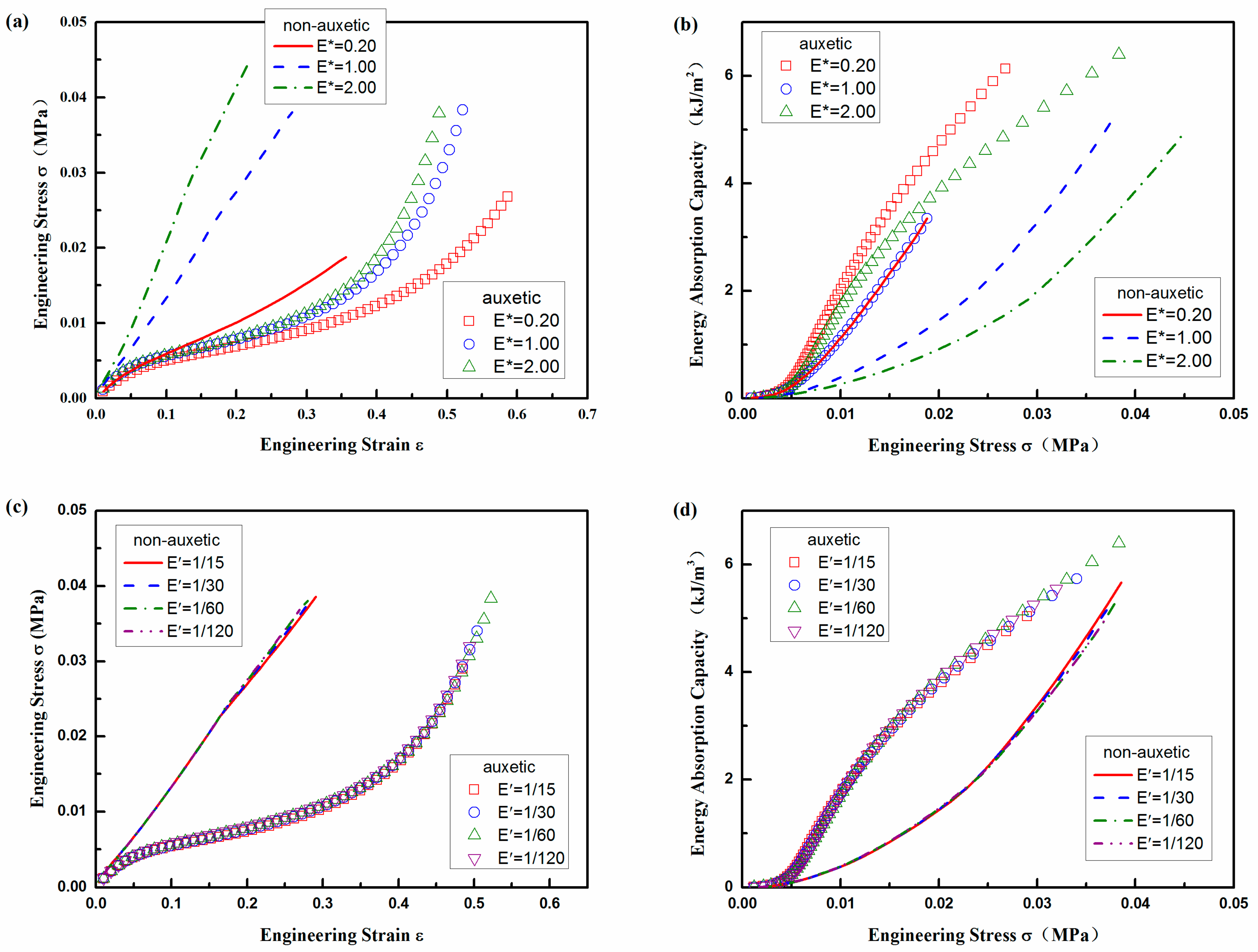
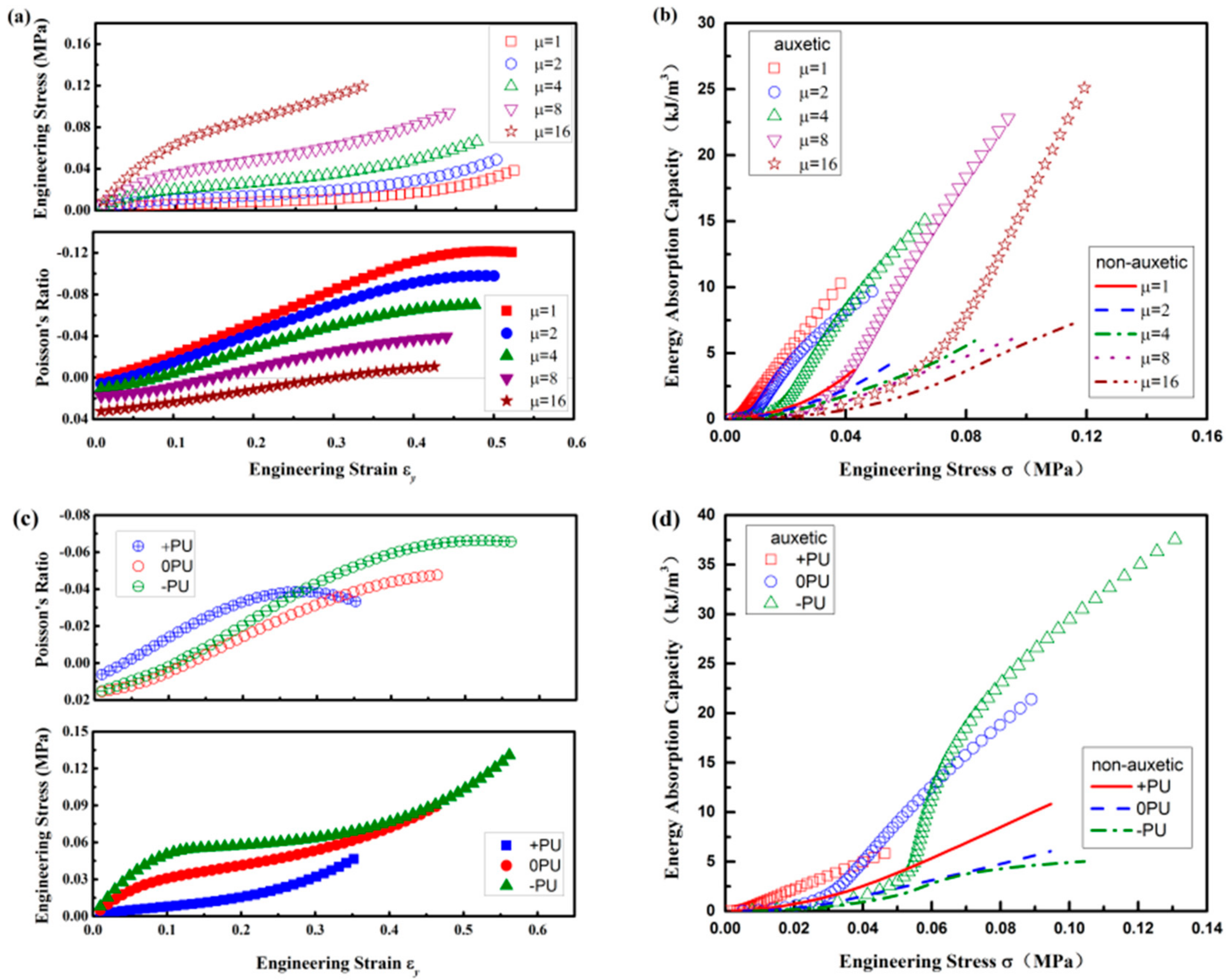
| D1 | D2 | Sx | Lx | Ly |
|---|---|---|---|---|
| 6 | 0.6 | 15 | 102 | 46.8 |
| Warp Yarn | Weft Yarn | PU Foam | |||||||
|---|---|---|---|---|---|---|---|---|---|
| Ex (MPa) | υ | Ex (MPa) | υ | μ1 (kPa) | μ2 (kPa) | α1 | α2 | β1 | β2 |
| 30 | 0.2 | 30 | 0.2 | 16.8 | 12.25 | 19.8 | 19.7 | 1.4 × 10−3 | 6.6 × 10−4 |
© 2018 by the authors. Licensee MDPI, Basel, Switzerland. This article is an open access article distributed under the terms and conditions of the Creative Commons Attribution (CC BY) license (http://creativecommons.org/licenses/by/4.0/).
Share and Cite
Zeng, J.; Hu, H. Finite Element Analysis of Three-Dimensional (3D) Auxetic Textile Composite under Compression. Polymers 2018, 10, 374. https://doi.org/10.3390/polym10040374
Zeng J, Hu H. Finite Element Analysis of Three-Dimensional (3D) Auxetic Textile Composite under Compression. Polymers. 2018; 10(4):374. https://doi.org/10.3390/polym10040374
Chicago/Turabian StyleZeng, Jifang, and Hong Hu. 2018. "Finite Element Analysis of Three-Dimensional (3D) Auxetic Textile Composite under Compression" Polymers 10, no. 4: 374. https://doi.org/10.3390/polym10040374




